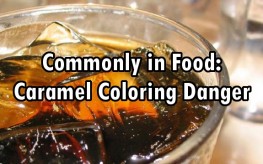Report: Most Common Coloring in Foods/Drinks Could Cause Cancer
Report: Most Common Coloring in Foods/Drinks Could Cause Cancer
It’s the most widely used food color in the world, though few know enough about caramel color to know it should be avoided.

According to Consumer Reports, 4-methylimidazole (4-Mel) has been shown to cause cancer in mice. The International Agency for Research on Cancer found it to be similarly “possibly carcinogenic to humans” in 2011. Though there is no federal limit for caramel color or it’s dangerous ingredient 4-Mel in foods and beverages, there is a limit in California.
Proposition 65, which became effective on January 7, 2012, requires food and beverage makers to label the products which could expose consumers to more than 29 micrograms of 4-Mel per day. The label warns of the potentially cancer-causing effects of the chemical.
For their study, Consumer Reportstested beverages from both California and New York State, and found several went over this 29 microgram limit. There were two rounds of testing, the first in April and the second in September of 2013. Some of the beverages which tested above the 29 mcg limit in the first round were far lower the second time—Pepsi in New York tested at 174 mcg in April and 32 in September. This suggests makers may be wising up to the dangers and reducing the amount of coloring in their drinks. Still, even some beverages in California, which fall under Proposition 65 requirements were over the 29 mcg limit and contained no warning.
These companies are backed by the FDAwhich maintains there is little to no risk in consuming caramel color. While they are currently reviewing their data, they maintain the colorant is safe despite evidence to the contrary.
In California, both Pepsi One and Malta Goya had more than 29 mcg per container and did not have a cancer warning label. When the manufacturers were contacted, Goya didn’t respond and Pepsi had an interesting perspective. They explained that according to their analysis, Proposition 65 applies to “per day” exposure, not per can of soda. They cited government data that shows the average diet soda consumer to drink 100 mL per day, less than one-third of one 12 ounce can. Therefore, they reason, one can does not meet the 29 mcg/day threshold and does not need a warning label.
“No matter how much consumers drink they don’t expect their beverages to have a potential carcinogen in them. And we don’t think 4-MeI should be in foods at all. Our tests of Coke samples show that it is possible to get to much lower levels,” said Urvashi Rangan, executive director of Consumer Reports’ Food & Sustainability Center.
Keep in mind, companies outside of California have no duty to limit the amount of caramel color or 4-Mel in their sodas or food products. And chances are if you look through your kitchen, you’ll find this additive listed on numerous packages.
Other Popular Stories:
Get The NaturalSociety Natural Health Newsletter!
Post a Comment